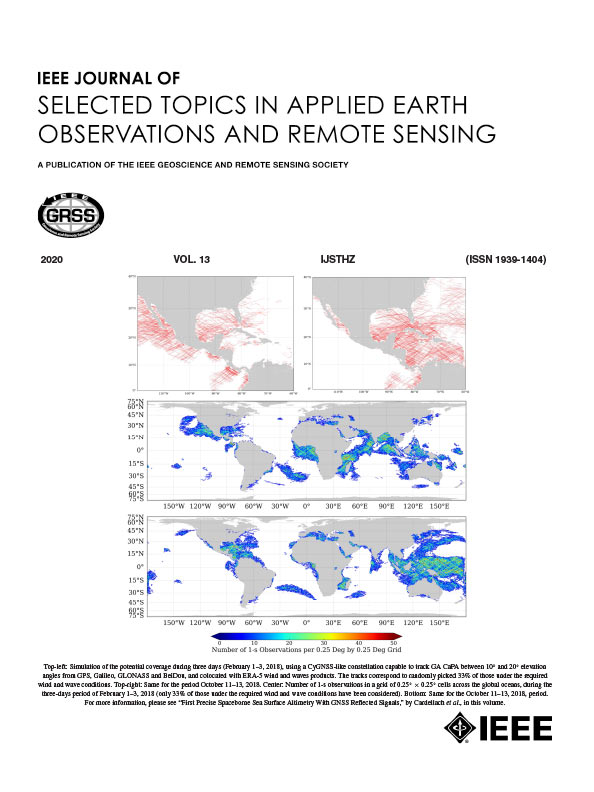基于与阴影LOLA DEM匹配细化结合点的LRO NAC图像控制网络构建
IF 5.3
2区 地球科学
Q1 ENGINEERING, ELECTRICAL & ELECTRONIC
IEEE Journal of Selected Topics in Applied Earth Observations and Remote Sensing
Pub Date : 2025-10-06
DOI:10.1109/JSTARS.2025.3616321
引用次数: 0
摘要
即将到来的月球南极探测活动需要高分辨率的测绘产品来支持着陆点的选择和导航。月球南极特殊的地形和光照条件对摄影测量处理提出了重大挑战。现有月球测绘产品在南极地区的覆盖范围和精度有限,无法满足探测任务的要求。本文提出了一种基于月球侦察轨道器窄角相机(NAC)图像近似正射影像与阴影数字高程模型(DEM)地图图像匹配细化结合点的控制网络构建方法。阴影DEM地图是利用月球轨道激光高度计地形模型生成的,与在轨NAC图像的获取时间相同,使其具有与在轨图像非常相似的光照条件。以阴影DEM图为过渡,通过计算正射影空间的同列变换矩阵,建立了NAC图像立体对之间的坐标变换关系。然后,将控制网络中的候选控制措施在正射影像空间中进行细化,再转换到原始图像空间中。我们利用月球南极附近的两组NAC图像进行了实验。实验结果表明,该方法能有效地解决月球南极图像的图像匹配和控制网络生成问题。本文章由计算机程序翻译,如有差异,请以英文原文为准。
Control Network Construction for LRO NAC Images Based on Refining Tie Points by Matching With Shaded LOLA DEM
The upcoming exploration activities in the lunar south pole require high-resolution mapping products to support landing site selection and navigation. The special terrain and illumination conditions in the lunar south pole pose significant challenges to photogrammetric processing. Existing lunar mapping products exhibit limited coverage and accuracy in the south pole region and cannot meet the exploration missions’ requirements. In this study, a new control network construction method is proposed based on refining tie points by image matching between the approximate orthophotos of lunar reconnaissance orbiter narrow-angle camera (NAC) images and shaded digital elevation model (DEM) maps. The shaded DEM maps are generated using lunar orbiter laser altimeter terrain models with the same acquisition time of on-orbit NAC images, making them have very similar illumination conditions to the on-orbit images. Using the shaded DEM maps as a transition, we establish the coordinate transformation relationship between the stereopairs of NAC images by computing the homograph transformation matrix in orthophoto space. Then, the candidate control measures in the control network are refined in orthophoto space and then converted to the original image space. We conducted experiments using two sets of NAC images near the lunar south pole. The experimental results demonstrate that the proposed method can effectively solve the problems of image matching and control network generation for lunar south pole images.
求助全文
通过发布文献求助,成功后即可免费获取论文全文。
去求助
来源期刊
CiteScore
9.30
自引率
10.90%
发文量
563
审稿时长
4.7 months
期刊介绍:
The IEEE Journal of Selected Topics in Applied Earth Observations and Remote Sensing addresses the growing field of applications in Earth observations and remote sensing, and also provides a venue for the rapidly expanding special issues that are being sponsored by the IEEE Geosciences and Remote Sensing Society. The journal draws upon the experience of the highly successful “IEEE Transactions on Geoscience and Remote Sensing” and provide a complementary medium for the wide range of topics in applied earth observations. The ‘Applications’ areas encompasses the societal benefit areas of the Global Earth Observations Systems of Systems (GEOSS) program. Through deliberations over two years, ministers from 50 countries agreed to identify nine areas where Earth observation could positively impact the quality of life and health of their respective countries. Some of these are areas not traditionally addressed in the IEEE context. These include biodiversity, health and climate. Yet it is the skill sets of IEEE members, in areas such as observations, communications, computers, signal processing, standards and ocean engineering, that form the technical underpinnings of GEOSS. Thus, the Journal attracts a broad range of interests that serves both present members in new ways and expands the IEEE visibility into new areas.

 求助内容:
求助内容: 应助结果提醒方式:
应助结果提醒方式:


